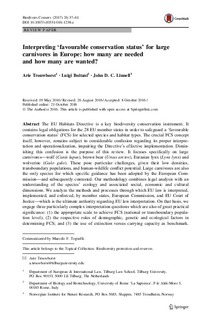| dc.contributor.author | Trouwborst, Arie | |
| dc.contributor.author | Boitani, Luigi | |
| dc.contributor.author | Linnell, John Durrus | |
| dc.coverage.spatial | Europe, Europa | nb_NO |
| dc.date.accessioned | 2017-05-22T14:10:12Z | |
| dc.date.available | 2017-05-22T14:10:12Z | |
| dc.date.created | 2017-03-02T10:00:33Z | |
| dc.date.issued | 2017 | |
| dc.identifier.citation | Biodiversity and Conservation. 2017, 26 37-61. | nb_NO |
| dc.identifier.issn | 0960-3115 | |
| dc.identifier.uri | http://hdl.handle.net/11250/2443208 | |
| dc.description.abstract | The EU Habitats Directive is a key biodiversity conservation instrument. It
contains legal obligations for the 28 EU member states in order to safeguard a ‘favourable
conservation status’ (FCS) for selected species and habitat types. The crucial FCS concept
itself, however, remains subject to considerable confusion regarding its proper interpretation
and operationalization, impairing the Directive’s effective implementation. Diminishing
this confusion is the purpose of this review. It focuses specifically on large
carnivores—wolf (Canis lupus), brown bear (Ursus arctos), Eurasian lynx (Lynx lynx) and
wolverine (Gulo gulo). These pose particular challenges, given their low densities,
transboundary populations, and human-wildlife conflict potential. Large carnivores are also
the only species for which specific guidance has been adopted by the European Commission—
and subsequently contested. Our methodology combines legal analysis with an
understanding of the species’ ecology and associated social, economic and cultural
dimensions. We analyze the methods and processes through which EU law is interpreted,
implemented, and enforced, by member states, European Commission, and EU Court of
Justice—which is the ultimate authority regarding EU law interpretation. On that basis, we
engage three particularly complex interpretation questions which are also of great practical
significance: (1) the appropriate scale to achieve FCS (national or transboundary population
level); (2) the respective roles of demographic, genetic and ecological factors in
determining FCS; and (3) the use of extinction versus carrying capacity as benchmark.
Regarding these questions, we identify approaches that are workable and effective, as well as likely to be endorsed by the EU Court. | nb_NO |
| dc.language.iso | eng | nb_NO |
| dc.rights | Navngivelse 4.0 Internasjonal | * |
| dc.rights.uri | http://creativecommons.org/licenses/by/4.0/deed.no | * |
| dc.subject | Favourable conservation status | nb_NO |
| dc.subject | FCS | nb_NO |
| dc.subject | Habitats Directive | nb_NO |
| dc.subject | Large carnivores | nb_NO |
| dc.subject | Law | nb_NO |
| dc.subject | Transboundary cooperation | nb_NO |
| dc.title | Interpreting ‘favourable conservation status’ for large carnivores in Europe: how many are needed and how many are wanted? | nb_NO |
| dc.type | Journal article | nb_NO |
| dc.type | Peer reviewed | nb_NO |
| dc.subject.nsi | VDP::Samfunnsgeografi: 290 | nb_NO |
| dc.subject.nsi | VDP::Human geography: 290 | nb_NO |
| dc.source.pagenumber | 37-61 | nb_NO |
| dc.source.volume | 26 | nb_NO |
| dc.source.journal | Biodiversity and Conservation | nb_NO |
| dc.identifier.doi | 10.1007/s10531-016-1238-z | |
| dc.identifier.cristin | 1455224 | |
| dc.relation.project | Norges forskningsråd: 212919 | nb_NO |
| cristin.unitcode | 7511,2,0,0 | |
| cristin.unitname | Avdeling for terrestrisk økologi | |
| cristin.ispublished | true | |
| cristin.fulltext | original | |
| cristin.qualitycode | 1 | |

